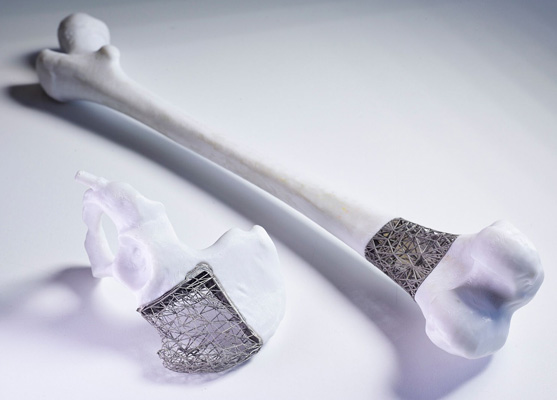Just in time implants set to radically advance tumour surgery
A major new Australian research project is set to transform the way physicians surgically treat tumours and bone cancer, and dramatically improve patient and healthcare outcomes.
Key points
- A five-year research project bringing together the Australian Government, RMIT University, the University of Technology Sydney (UTS), St Vincent’s Hospital Melbourne and global medical technology firm Stryker.
- Worth more than $12.1 million in research effort, funded by Stryker with IMCRC contributing $2.36 million in cash.
- Combing 3D printing, robotic surgery and advanced manufacturing to create tailored implants for patients with bone cancer.
The five-year project, “Just in time implants”, brings together the Australian Government, RMIT University, the University of Technology Sydney (UTS), St Vincent’s Hospital Melbourne and global medical technology firm Stryker.
Worth more than $12.1 million in research effort, the work is funded by Stryker with co-funding from the Innovative Manufacturing Cooperative Research Centre (IMCRC), which is contributing $2.36 million in cash.
Lead researcher, RMIT’s Professor Milan Brandt, and the project team will combine 3D printing, robotic surgery and advanced manufacturing to create tailored implants for patients with bone cancer.
“Our aim is to bring the technology to the theatre,” Brandt said. “While patients are having their cancer removed in the operating theatre, in the next room, we are custom printing an implant to precisely fill the space left after removal of the diseased bone.”
St Vincent’s Hospital’s Professor Peter Choong said just in time implants will transform the delivery of care for people with bone cancer.
“By combining specialised imaging techniques, 3D printing and the accuracy of robotic assisted surgery, we are aiming to deliver a personalised implant in time for the surgeon to remove the cancer and repair the patient’s bone in the one operation,” Choong said.
“This process will expand the surgical options available to patients and surgeons and increase the potential for limb saving surgery.”
The novel process represents a major shift in the way implants are designed, manufactured and supplied and could lead to bespoke local manufacturing.
“This is the future of implants and robotic surgery,” said Director, Research and Development for Stryker South Pacific Rob Wood. “Australia is leading the way globally in developing and implementing new manufacturing models and technology in the medical space – combining robotic surgery and additive manufacturing.
“We are extremely excited about this project and the incredible benefits that this research will deliver to patients in Australia and across the world.”
David Chuter, IMCRC CEO and Managing Director said that the project was a great example of how research-led innovation in manufacturing drives better products, services and processes.
“This is a significant research investment into Australia by Stryker – seeing a global organisation collaborating with two Australian universities and a local hospital. It highlights how Australia’s medtech environment offers research partners a unique setting for innovative research programs,” said Chuter.
“Specifically, this project will establish advanced manufacturing capabilities that will ensure competitive advantage domestically and internationally.
“It will also train a new generation of engineers and researchers in medical robotics and the additive manufacturing of medical implants.”
Professor Emmanuel Josserand, Director of the Centre for Business and Social Innovation at UTS, said the project would also have a wider impact for business and the economy, as Australia transitions from traditional to advanced manufacturing.
“Not only will there be direct business opportunities for Australian companies to become medical suppliers to Stryker, with its global supply chains, but there will also be an opportunity for the technologies and manufacturing know-how developed within this project to transfer over time to other local industries,” Professor Josserand said.
“These sorts of advanced manufacturing capabilities will ensure competitive advantage for Australian businesses, domestically and internationally.”

